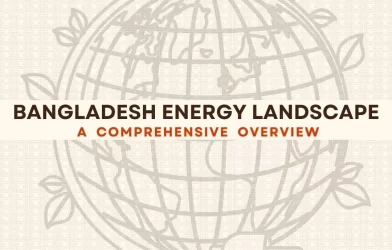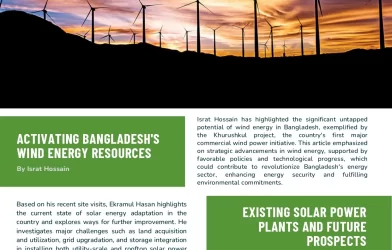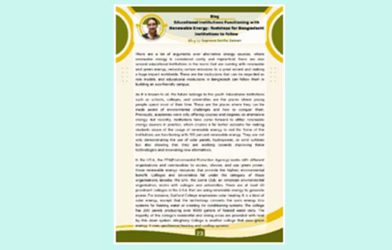Event Summary:
South Asian Network on Economic Modeling (SANEM) has recently arranged a webinar titled “Misconceptions about Renewable Energy in Bangladesh” (নবায়নযোগ্যজ্বালানিনিয়েযতভুলধারণা ) on 9 August 2023 at online platform Zoom. The objective of the webinar was to address and debunk the dominant misconceptions revolving around Renewable Energy existing in people’s minds in Bangladesh. The webinar opened with welcome remarks from Dr Sayema Haque Bidisha, Professor at the Department of Economics, University of Dhaka, and Research Director of SANEM. In her welcome remarks, Dr Bidisha introduced the panelists, welcomed the guests, and further highlighted the inspiration behind organizing the webinar. She briefly introduced the background saying that Renewable Energy has become crucial since global warming and the change in climate pattern induced by consequent temperature rise has been a persisting phenomenon on the earth. Without proper management of fossil fuel-based production systems and transitioning toward a Renewable Energy-based carbon-free green society, the downgrading of our already endangered environment. The webinar was moderated by Ms Israt Hossain, Senior Research Associate, SANEM.
The panel discussion included esteemed experts in the field, including:
- Dr Mohammad Tamim, Dean of Faculty of Chemical and Materials Engineering, Bangladesh University of Engineering and Technology (BUET);
- Shafiqul Alam, Energy Finance Analyst for Bangladesh, Institute for Energy Economics and Financial Analysis;
- Moshahida Sultana, Associate Professor, Department of Accounting and Information System (AIS), University of Dhaka.
Not only did the panelists lend thought-provoking insights and address the technical aspects of the issues related to renewable energy, but they also offered feasible solutions and alternative scenarios regarding the challenges of harnessing renewable resources in Bangladesh.
Mr Shafiqul Alam started by saying that reaching 24000 MW on the basis of installed capacity by 2041 is obviously challenging, however, we can proceed by following a year-wise (annual) action plan rather than following such a big long-term target. On the issue of land scarcity, he highlighted that although it is a challenge since we must abide by the policy obligation, we can go for a combination of options such as utilization of utilityscale land-based solar projects, rooftop solar PV, and offshore (and onshore) wind-based projects. We have to explore rigorously the true potential of rooftop solar finding the scope of current and future industrial rooftop and educational institutions rooftops, and by utilizing those options we can get several thousands of MW of power. Similarly, we can do the same for utility-scale land-based solar projects and wind-based projects. Also, the long-standing import duty on four solar accessories needs to be exempted immediately because the aggregate return it will generate will surely surpass the revenue the government is collecting from current import duties. To better manage the land scarcity the government can make an effective integrated resource mapping. BPDB itself can initiate some projects in place of old fuel-based plants which is also called repurposing of old inefficient power plants, which can reduce per-unit generation cost of electricity, for cost-cutting is another major objective of RE. The cost of storage is currently very high, it’s true. We can do some pilot projects but large-scale storage-based projects are not feasible yet, even in India, the price is not agreeable. What we can do is design the system in such a way that our daytime peak demand can be met by solar power and night-time peak demand by wind power. In that way, we can bypass the storage issue now. A moderate portion of the total revenue shortfall of the power sector can be set aside for RE development so that its progress doesn’t get hampered.
MsMoshahida Sultana highlighted with reference to her research some points on the issues and prevailing misconceptions that make us lag behind in this sector. It is important to understand While considering RE which groups the misconceptions are prevalent among and why so, what is the context behind these misconceptions, otherwise it may lead to further misconceptions. During the early 2010s, when the production cost of solar and wind power started falling many countries declared with enthusiasm that they will fully shift to them. However, especially from the Justice point of view some issues such as rehabilitating and compensating the coal workers, etc, aroused, and the international coal lobby was also in action, so the countries couldn’t realize what they thought they can. At that time, among policymakers, experts, and common people there were some negative attitudes induced by confusion and lack of reliability regarding whether Solar can manage the base load demand, how to serve night-time peak demand, the cost of storage, grid capacity, etc. Hence attention was primarily on coal and LNG. As the RE technology continues developing some of the attitudes have been positively changed. However, to what scale we can expand and achieve from RE is still debated. In that case, we can talk about some relevant scenarios, especially that of Vietnam. Vietnam has successfully enhanced a great of deal power, nearly 16000 MW, from RE within just a couple of years. What they remarkably did was utilize their rooftops. Therefore, the experience of Vietnam really challenges the notion that solar development is not possible without a big mass of land. In the case of land-based utility-scale solar, the complaints were mostly from commercial investors and solar developers due to legal and practical difficulties in land acquisition, and, the availability estimates of land in riverine Char areas, Khaas lands were also highly contested with the practical experience. However, with better policy indication and efficient management at the implementation level could have solved this issue with comfort. Besides, with rapidly changing technology, it is possible now to generate more power with less land and cheaper cost, Kaptai is an example at hand. The same goes with RE waste management, with convenient technology coming in the future thanks to global investments and innovation in this sector we can dispose of or recycle them efficiently. Another big misconception stemmed from the solar home system. In terms of quality and performance, these were really out of place which created a lot of confusion and negative impressions at the consumer level. Due to this bitter experience at the local consumer level, people lost their interest in solarrelated discussions. Moreover, the efforts to reverse this process and restore faith in solar were minimal from all sides—the government, the NGOs, and the importers. Finally, by carefully assessing the capability and preparedness to adopt the technology, proper policy guidelines, providing adequate economic incentives, and building institutional capacity, we can overcome all difficulties and achieve a great deal in RE in the coming ages.
Dr Tamim emphasized the urgency of policy revision since, according to him, our entire RErelated policy over the years has largely failed. He raised the question of and insights on why Bangladesh can’t reach at least 1000 MW of capacity from RE in the last 15 years. According to him, the allocated lands for land-based utility-scale projects were in most cases remote, and in those cases, it occurred that the cost of transmission is greater than the overall project cost. There was also a lack of incentives, for instance, if the feed-in tariff system could be accommodated, an integrated resource planning could be adopted the solar capacity could have been enhanced more. Most importantly, at the heart of this failure lies the lack of significant public investment and enterprise. Building any utility-scale RE project at the current stage needs the government’s direct involvement in public investment, implementation and monitoring, and finally, attracting private investments. According to a recent study conducted by World Bank, 5 abandoned coal sites are recommended to be reallocated to install solar entailing an aggregate potential capacity of around 6000 MW. Since these projects are understandably large-scale the government can proceed gradually—not all overnight– through Public Private Partnerships, and as Mr Shafique aptly remarked earlier, the government shouldn’t be bothered about gigantic long-term targets, rather the whole power sector should be reorganized with a solid plan, and a clear understanding of demand and supply for five years at a time the estimates of which can appropriately be done by a ‘bottom-up’ approach. The central planning that we currently have is not working, we need a distributive approach. The new wind project in Cox’bazar is performing well above its break-even point, but we have to wait year-round to deliver judgment on the wind potential of Bangladesh. Nevertheless, this particular pilot project gives us glimmering hope. If a subsidy is needed in this sector, it has to be given but, importantly, not in an unsolicited manner. Considering the limitations of RE-based power generation such as variable load and the ensuing grid management under the current legacy system, Dr Tamim also emphasized the system to be designed in such a way that our daytime peak demand can be met by solar power and night-time peak demand by wind power as long as the storage facility doesn’t become commercially viable. Above all, at the government level the attitude toward RE must be changed, the government needs to be more affirmative in that case. The political will of the government, proper policy formulation and planning, and the direct involvement of PGCB will play a crucial role in transitioning to a sustainable future. The independent system of operator (ISO, the national load dispenses sector) must be automated to stabilize the load streams in the national grid because the source of power has now become more diversified with the addition of Solar, Wind, and especially Nuclear power plants.
Now, RE should no doubt contribute the maximum in power generation in principle, at the same time, in practice we should also keep in mind our economic growth. As the RE roll-out is still slow we cannot forgo the power demand and economic growth waiting for RE to catch up. if needed, we have to use fossil fuels to keep the economy running. And the development and shift toward RE should be following a simultaneous and gradual replacement. Following the panelists’ discussion, a large number of the audience expressed their opinions on an array of issues relevant to the topic. They presented their questions and the panelists addressed them duly.
In her concluding speech, Dr Bidisha expressed her gratitude to all the panelists and attendees for their valuable insights and engaging participation. She highlighted and summarized the webinar in four significant points which are financing, costeffectiveness, commercial viability, and sustainability. An urgency for cost-efficient management while managing RE-induced wastes, land acquisition, target setting, attracting FDI, and, most importantly monitoring budget incentives was also resonated in her speech. Dr Bidisha concluded the webinar by saying that careful inclusion of all cost components—economic and environmental—by internalizing the externalities and understanding the political economy of RE underlying the whole Power and energy sector is crucial to facilitate the transitional pathway toward a clean and sustainable future.
Video Link:https://www.youtube.com/watch?v=ogCaCIqKZn4
News Links:
- The Financial Express: Experts for proper plan, policy support
- The Business Standard:Green power generation limping: Analysts
- Risingbd.com:Complexity is main obstacle to renewable energy sector












